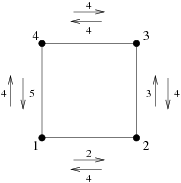
Zadanie Mosty (mos)
Pomóż nam usprawnić bazę zadań!
Mosty
Limit pamięci: 64 MB
San Bajcisko to pięknie położone nadmorskie miasto.
Składa się ono z  niewielkich, ale gęsto zaludnionych wysp, ponumerowanych
od
niewielkich, ale gęsto zaludnionych wysp, ponumerowanych
od  do
do  .
Pewne pary wysp są połączone mostami, którymi poprowadzono
dwukierunkowe drogi.
Każda para wysp może być połączona co najwyżej jednym mostem.
Z każdej wyspy San Bajciska można dotrzeć do dowolnej innej, przemieszczając
się pomiędzy wyspami wyłącznie za pomocą mostów.
.
Pewne pary wysp są połączone mostami, którymi poprowadzono
dwukierunkowe drogi.
Każda para wysp może być połączona co najwyżej jednym mostem.
Z każdej wyspy San Bajciska można dotrzeć do dowolnej innej, przemieszczając
się pomiędzy wyspami wyłącznie za pomocą mostów.
Bajtazar i Bajtek wybierają się na przejażdżkę rowerową po San Bajcisku.
Swoją wycieczkę zaczną na wyspie nr 1.
Chcą zwiedzić miasto, przejeżdżając każdym mostem dokładnie raz, i zakończyć podróż
na wyspie nr  .
Niestety, w wycieczce będzie im przeszkadzał... wiatr.
Otóż na każdym moście strasznie wieje, co w różnym stopniu może
utrudniać przejazd rowerowy mostem w jedną bądź w drugą stronę.
Dla uproszczenia zakładamy, że przy ustalonym kierunku przejazdu przez
dany most siła wiatru jest stała.
.
Niestety, w wycieczce będzie im przeszkadzał... wiatr.
Otóż na każdym moście strasznie wieje, co w różnym stopniu może
utrudniać przejazd rowerowy mostem w jedną bądź w drugą stronę.
Dla uproszczenia zakładamy, że przy ustalonym kierunku przejazdu przez
dany most siła wiatru jest stała.
Pomóż Bajtazarowi i Bajtkowi znaleźć taką trasę spełniającą ich wymagania, po przejechaniu której będą najmniej zmęczeni. Jako miarę tego, na ile trasa jest męcząca, przyjmujemy maksymalną siłę wiatru, z jaką nasi bohaterowi będą musieli zmagać się na trasie.
Wejście
W pierwszym wierszu standardowego wejścia znajdują się dwie liczby całkowite
oddzielone pojedynczym odstępem:  oraz
oraz  (
( ,
,  ),
oznaczające odpowiednio liczbę wysp oraz liczbę mostów w San Bajcisku.
Wyspy są ponumerowane od 1 do
),
oznaczające odpowiednio liczbę wysp oraz liczbę mostów w San Bajcisku.
Wyspy są ponumerowane od 1 do  , a mosty od 1 do
, a mosty od 1 do  .
W kolejnych
.
W kolejnych  wierszach znajdują się opisy mostów.
wierszach znajdują się opisy mostów.
 -szy wiersz zawiera cztery liczby całkowite
-szy wiersz zawiera cztery liczby całkowite  ,
,  ,
,  ,
,  (
( ,
,  ,
,  ),
pooddzielane pojedynczymi odstępami.
Liczby te opisują most nr
),
pooddzielane pojedynczymi odstępami.
Liczby te opisują most nr  łączący wyspy o numerach
łączący wyspy o numerach  oraz
oraz  .
Siła wiatru, jaki przeszkadza w trakcie przejazdu rowerem z wyspy
.
Siła wiatru, jaki przeszkadza w trakcie przejazdu rowerem z wyspy
 do
do  , to
, to  ; jeżeli zaś przejechać tym samym mostem
z wyspy
; jeżeli zaś przejechać tym samym mostem
z wyspy  do
do  , to przeszkadzający wiatr będzie miał siłę
, to przeszkadzający wiatr będzie miał siłę  .
.
Wyjście
Jeżeli nie istnieje żadna trasa spełniająca wymagania naszych bohaterów,
to pierwszy i jedyny wiersz standardowego wyjścia powinien zawierać jedno słowo
NIE.
W przeciwnym przypadku wyjście powinno składać się z dwóch wierszy,
opisujących najmniej męczącą trasę wycieczki po San Bajcisku.
Pierwszy z nich powinien zawierać jedną liczbę całkowitą: największą siłę wiatru,
jaki będzie wiał w trakcie wycieczki.
Właśnie tę liczbę należy zminimalizować.
W drugim wierszu powinno znaleźć się  liczb całkowitych, pooddzielanych
pojedynczymi odstępami i oznaczających numery mostów, którymi kolejno
przejeżdża się na najmniej męczącej trasie.
liczb całkowitych, pooddzielanych
pojedynczymi odstępami i oznaczających numery mostów, którymi kolejno
przejeżdża się na najmniej męczącej trasie.
Jeśli istnieje więcej niż jedna poprawna odpowiedź, Twój program powinien wypisać dowolną z nich.
Przykład
Dla danych wejściowych:
4 4 1 2 2 4 2 3 3 4 3 4 4 4 4 1 5 4

poprawną odpowiedzią jest:
4 4 3 2 1
Wyjaśnienie do przykładu:
Optymalna trasa Bajtazara i Bajtka ma postać:
 .
Maksymalna siła wiatru na tej trasie wynosi
.
Maksymalna siła wiatru na tej trasie wynosi  .
.
Autorzy zadania: Szymon Acedański, Jakub Radoszewski.
Kontakt
In the event of technical difficulties with Szkopuł, please contact us via email at [email protected].
If you would like to talk about tasks, solutions or technical problems, please visit our Discord servers. They are moderated by the community, but members of the support team are also active there.

 English
English